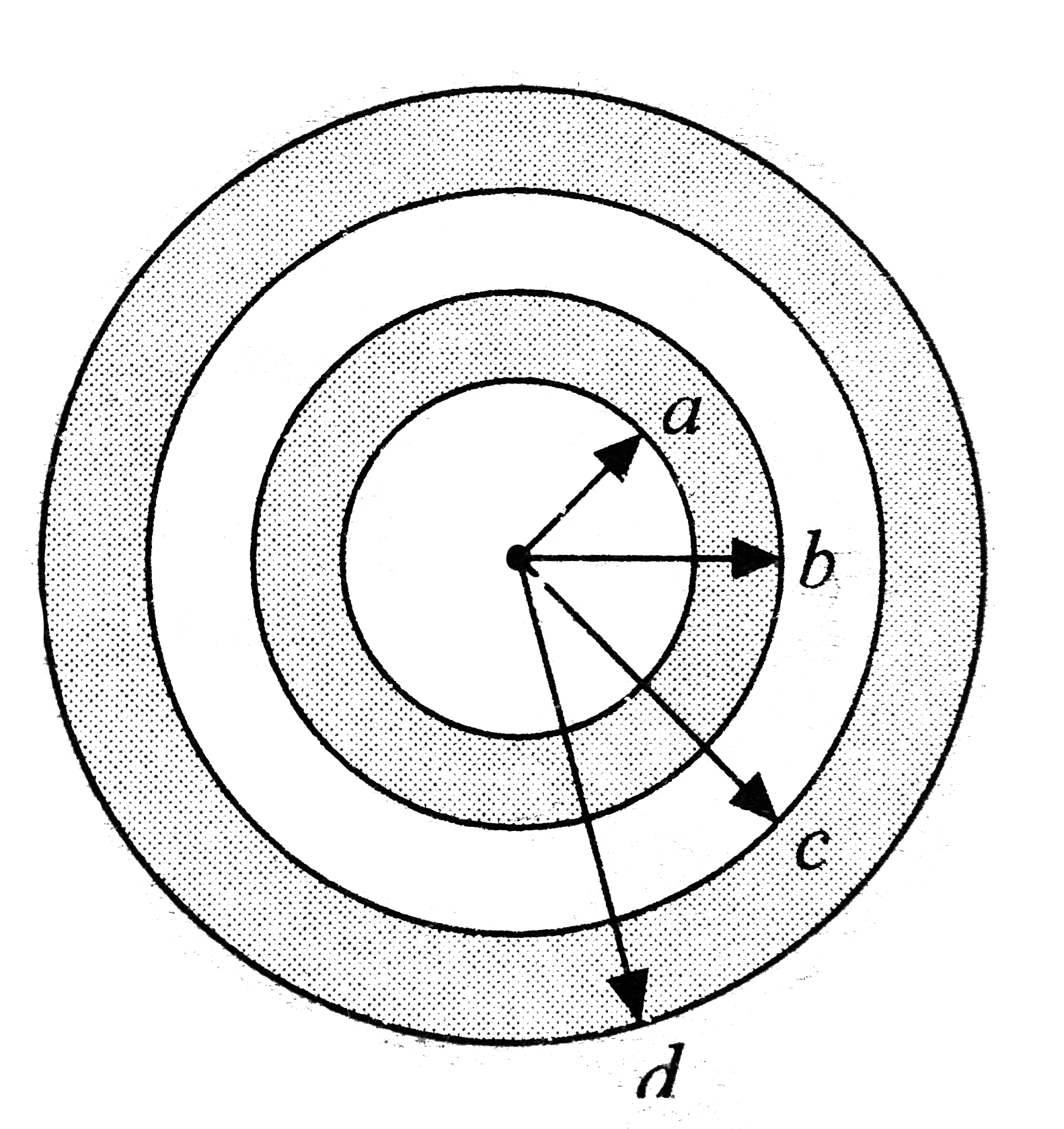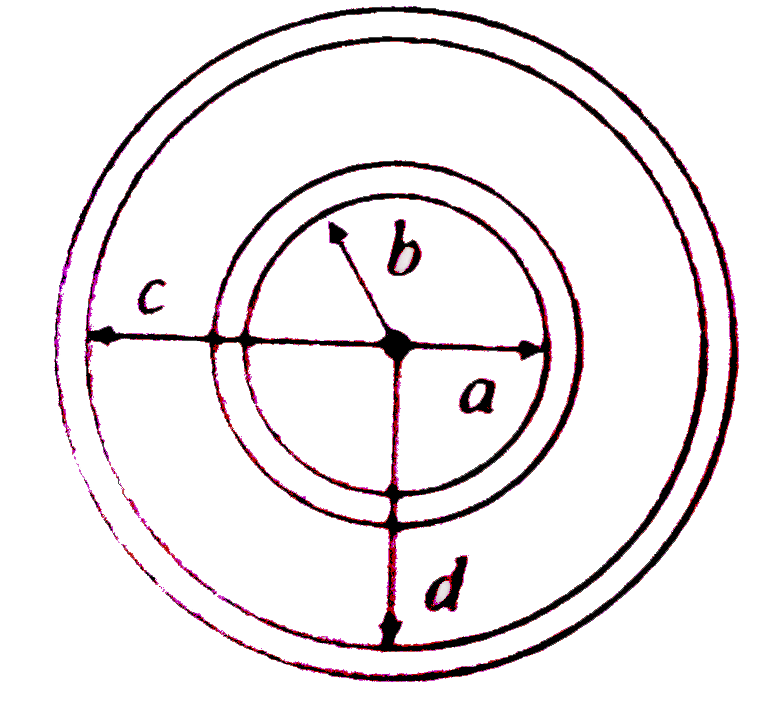Consider the previous problem , let the outer shell have the charge −4q. As in the above problem , the inner shell has the charge +2q. Calculate the electric field in terms of q and the distance r from the common center of the two shells for
a<r<b
zero
14πε02qr2
−14πε02qr2
14πε06qr2
The correct Answer is:A
To solve the problem, we need to calculate the electric field in the region between the inner shell and the outer shell, specifically for the distance r where a<r<b.
1. Identify the Charges:
- The inner shell has a charge of +2q.
- The outer shell has a charge of −4q.
2. Understand the Region:
- We are interested in the region where a<r<b. This means we are looking at points that are outside the inner shell but inside the outer shell.
3. Apply Gauss's Law:
- According to Gauss's Law, the electric field E through a closed surface is proportional to the charge enclosed by that surface:
ΦE=∮E⋅dA=Qencϵ0
- Here, ΦE is the electric flux, E is the electric field, dA is the differential area, and Qenc is the charge enclosed by the Gaussian surface.
4. Choose a Gaussian Surface:
- We will choose a spherical Gaussian surface of radius r such that a<r<b.
5. Calculate the Enclosed Charge:
- In this region, the only charge enclosed by our Gaussian surface is the charge of the inner shell, which is +2q. The charge on the outer shell does not contribute to the enclosed charge because it is outside our Gaussian surface.
6. Substitute into Gauss's Law:
- Since the only charge enclosed is +2q, we can write:
∮E⋅dA=Qencϵ0=2qϵ0
- The left side can be expressed as E⋅4πr2 (the surface area of a sphere):
E⋅4πr2=2qϵ0
7. Solve for the Electric Field E:
- Rearranging the equation gives:
E=2q4πϵ0r2=q2πϵ0r2
Final Answer:
The electric field E in the region a<r<b is:
E=q2πϵ0r2
- The inner shell has a charge of +2q.
- The outer shell has a charge of −4q.
- We are interested in the region where a<r<b. This means we are looking at points that are outside the inner shell but inside the outer shell.
- According to Gauss's Law, the electric field E through a closed surface is proportional to the charge enclosed by that surface:
ΦE=∮E⋅dA=Qencϵ0
- Here, ΦE is the electric flux, E is the electric field, dA is the differential area, and Qenc is the charge enclosed by the Gaussian surface.
- We will choose a spherical Gaussian surface of radius r such that a<r<b.
- In this region, the only charge enclosed by our Gaussian surface is the charge of the inner shell, which is +2q. The charge on the outer shell does not contribute to the enclosed charge because it is outside our Gaussian surface.
- Since the only charge enclosed is +2q, we can write:
∮E⋅dA=Qencϵ0=2qϵ0
- The left side can be expressed as E⋅4πr2 (the surface area of a sphere):
E⋅4πr2=2qϵ0
- Rearranging the equation gives:
E=2q4πϵ0r2=q2πϵ0r2
The electric field E in the region a<r<b is:
E=q2πϵ0r2
Topper's Solved these Questions
- ELECTRIC FLUX AND GAUSS LAWBOOK - CENGAGE PHYSICS ENGLISHCHAPTER - ELECTRIC FLUX AND GAUSS LAWEXERCISE - Subjective type
7 Videos
- ELECTRIC FLUX AND GAUSS LAWBOOK - CENGAGE PHYSICS ENGLISHCHAPTER - ELECTRIC FLUX AND GAUSS LAWEXERCISE - MCQ s
38 Videos
- ELECTRIC FLUX AND GAUSS LAWBOOK - CENGAGE PHYSICS ENGLISHCHAPTER - ELECTRIC FLUX AND GAUSS LAWEXERCISE - Multiple Correct
8 Videos
- ELECTRIC CURRENT AND CIRCUITBOOK - CENGAGE PHYSICS ENGLISHCHAPTER - ELECTRIC CURRENT AND CIRCUITEXERCISE - Interger
8 Videos
- ELECTRIC POTENTIALBOOK - CENGAGE PHYSICS ENGLISHCHAPTER - ELECTRIC POTENTIALEXERCISE - DPP 3.5
15 Videos
Similar Questions
Consider the previous problem , let the outer shell have the charge −4q. As in the above problem , the inner shell has the charge +2q. Calculate the electric field in terms of q and the distance r from the common center of the two shells for
r<a
View SolutionConsider the previous problem , let the outer shell have the charge −4q. As in the above problem , the inner shell has the charge +2q. Calculate the electric field in terms of q and the distance r from the common center of the two shells for
b<r<c
View SolutionConsider the previous problem , let the outer shell have the charge −4q. As in the above problem , the inner shell has the charge +2q. Calculate the electric field in terms of q and the distance r from the common center of the two shells for
c<r<d
View SolutionConsider the previous problem , let the outer shell have the charge −4q. As in the above problem , the inner shell has the charge +2q. Calculate the electric field in terms of q and the distance r from the common center of the two shells for
The graph of the radial component of E as function of r will be
View SolutionA small conducting spherical shell with inner radius a and outer radius b is concentric with a larger conducting spherical shell with inner radius c and outer radius d ( as shown in Fig . 2.121). The inner shell has a total charge +2q, and the outer shell has a total charge +4q. Calculate the electric field in terms of q and the distance r from the common center of the two shells for

b<r<c
View SolutionA small conducting spherical shell with inner radius a and outer radius b is concentric with a larger conducting spherical shell with inner radius c and outer radius d ( as shown in Fig . 2.121). The inner shell has a total charge +2q, and the outer shell has a total charge +4q. Calculate the electric field in terms of q and the distance r from the common center of the two shells for

a<r<b
View SolutionA small conducting spherical shell with inner radius a and outer radius b is concentric with a larger conducting spherical shell with inner radius c and outer radius d ( as shown in Fig . 2.121). The inner shell has a total charge +2q, and the outer shell has a total charge +4q. Calculate the electric field in terms of q and the distance r from the common center of the two shells for

r<a
View SolutionA small conducting spherical shell with inner radius a and outer radius b is concentric with a larger conducting spherical shell with inner radius c and outer radius d ( as shown in Fig . 2.121). The inner shell has a total charge +2q, and the outer shell has a total charge +4q. Calculate the electric field in terms of q and the distance r from the common center of the two shells for

c<r<d
View SolutionA small conducting spherical shell with inner radius a and outer radius b is concentric with a larger conducting spherical shell with inner radius c and outer radius d. The inner shell has total charge +2q, and the outer shell has charge +4q. (K=(1)/(4piepsilon_(0)))

Find the electric field in terms of q and the distance r from the common centre of the two shells for (i) b<r<c (ii) c<r<d
View SolutionA small conducting spherical shell with inner radius a and outer radius b is concentric with a larger conducting spherical shell with inner radius c and outer radius d. The inner shell has total charge +2q and the outer shell has charge +4q.
(i) What is the total charge on the (a) inner surface of the small shell, (b) outer surface of the small shell (c) inner surface of the large shell, (d) outer surface of the large shell ?
(ii) Calculate the electric field in terms of q and the the distance r from the common centre of two shells for (a) r<a, (b) a<r<b, (c) b<r<c, (d) c<r<d, (e) r>d

View Solution
